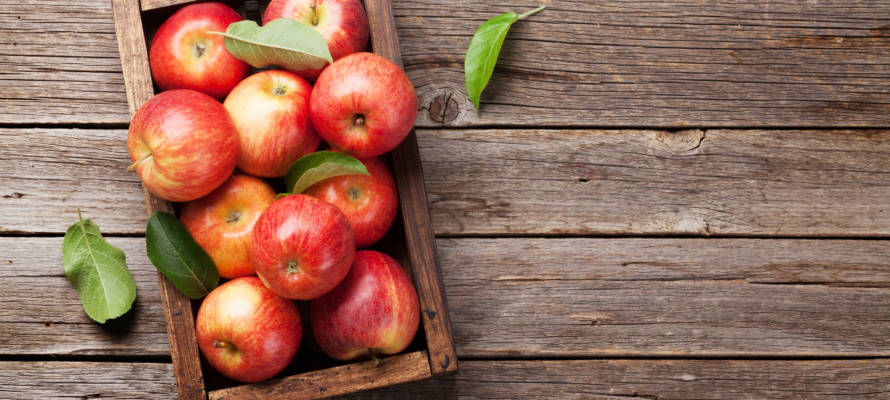There is much discussion in rabbinic literature as to whether the forbidden fruit was in fact an apple. Does it even matter?
By Rabbi Ari Enkin, Rabbinic Director, United with Israel
This week’s Torah portion is “Bereishit” (Genesis 1:1-6:8), and in it we read the story of Adam and Eve and the sin of the forbidden fruit.
Although many believe that the forbidden fruit of Eden was an apple, it seems from Jewish sources that this was not the case.
Indeed, the Torah itself does not say what type of tree the “Tree of Knowledge” was. The Jewish sages gave a number of suggestions as to what the forbidden fruit was, and an apple is not one of them.
Let’s see what the rabbis of the Talmud and the Midrash have to say about the identity of the forbidden fruit.
Believe it or not, one of the leading candidates is wheat! That’s right! Wheat may have been the forbidden fruit of Eden. This is based on a Jewish teaching that connects “wheat” with “knowledge.” According to this approach, wheat grew on trees in Eden.
Alternatively, it is suggested that wheat grew very tall and resembled a tree due to its height. There is also a view that the wheat in Eden produced ready to eat bread and that the forbidden fruit was actually bread!
A slightly more well-known candidate, with some scriptural backing, is that the forbidden fruit was a fig. This is based on the fact that right after Adam and Eve sinned, they realized that they were naked and therefore made garments of fig leaves.
The assumption is that they used fig leaves because the fig trees were within immediate reach and hence very possibly the tree of the forbidden fruit as well.
There is also an opinion that the forbidden fruit was a grape. This is based on the observation that grapes, and more specifically wine, has been the source of all types of misery and unfortunate events throughout scripture.
There is also a teaching that “wine makes one wise,” which would make it a candidate for a “tree of knowledge.” Closely related to this is the custom for women not to drink the wine from the Havdalah ceremony Saturday nights at the conclusion of Shabbat as a reminder of the sin that Eve committed.
In fact, some say that Eve made wine out of the grapes and that was what she gave Adam to drink.
Some say that the forbidden fruit was the “etrog,” the lemon-like fruit that is central to the holiday of Sukkot. This is largely based on the fact that the verse states that “the tree was good for eating.” It is taught that the etrog tree is the only tree in which the bark tastes like the fruit it grows.
It is also taught that the etrog is used on Sukkot in order to atone for the sin of the forbidden fruit.
There is even a view that the forbidden fruit was a banana. This is based on a translation of banana that was rendered “the apple of Eden” in rabbinic texts. In other early works as well, the banana was associated with the episode in Eden. Indeed, in Latin, there is a species of bananas that are known as “Musa Paradisiaca” (fruit of paradise) and a species “Musa Sapientum “(fruit of knowledge), lending some support to the Eden theory.
Ultimately, however, the banana was never really accepted as a true candidate for the forbidden fruit in rabbinic circles.
There are also theories that the forbidden fruit was a sabra or even a mushroom, but these theories have little proof to back them up and have not been taken seriously among scholars.
So how did the apple become so associated with the forbidden fruit?
A likely possibility is that the ancient word for “citrus fruits,” “round fruits,” and even the “etrog” was “tapuach,” which also means “apple.” Indeed, “apple” was often simply synonymous with “fruit” in general. There is also the possibility that the confusion came from Latin, in which the terms used for “tree” and “apple” are very similar.
It is ultimately not important what the forbidden fruit was, and in fact, the Talmud teaches that it was intentionally hidden from us. What is important is to internalize the entire episode and realize that there are boundaries, rules, and restrictions in life that we must adhere to. It is the life of observance of the Torah, not unrestricted freedom, that is truly “paradise.”
This article is based partly on the work of Rabbi Dr. Ari Zivotofsky at https://jewishaction.com/religion/jewish-law/whats-truth-apple-garden-eden/ .
For more articles by Rabbi Enkin on this week’s Torah portion, click on the links below:
https://unitedwithisrael.org/living-torah-creation-of-man-was-it-good/
https://unitedwithisrael.org/living-torah-be-open-to-constructive-criticism/
https://unitedwithisrael.org/israel-for-the-jews/
https://unitedwithisrael.org/living-torah-everything-old-is-new-again/
